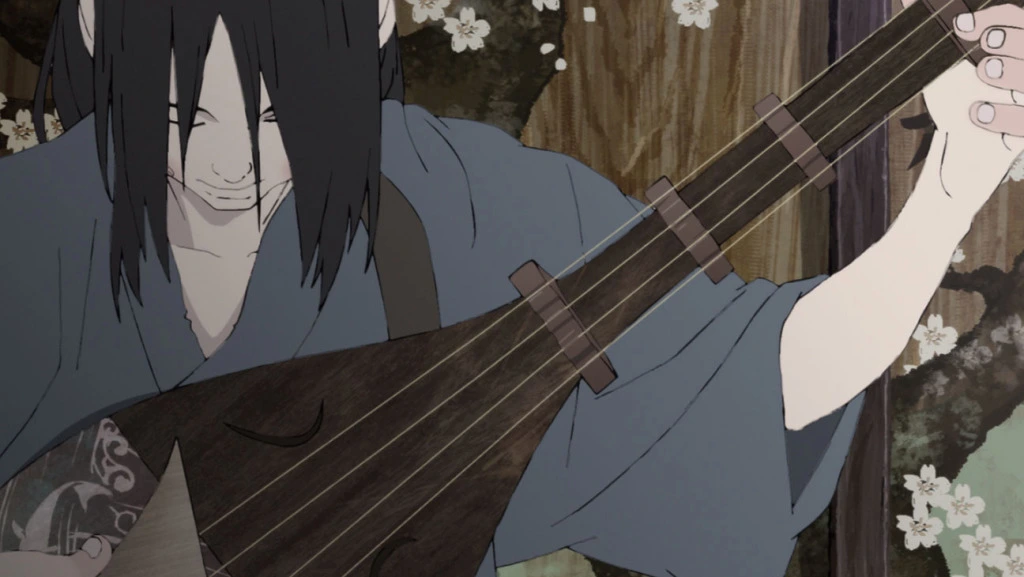Masaaki Yuasa is one of the best directors working in animation today. With his energized and free-spirited approach to directing, with animation that tilts the form on its side and dares others to be as exhilaratingly innovative, he’s seen a steady rise in popularity ever since his feature film debut, the gonzo Mind Game. In recent years his projects have included the nihilistic fever dream Devilman Crybaby for Netflix, the heart-wrenching melodrama Ride Your Wave, the love letter to animation and creatives, Keep Your Hands of Eizouken!, and the delightful Lu Over the Wall.
It’s the latter that best sets the precursor for his latest film, Inu-Oh, the period piece based on the Hideo Furukawa book Tales of the Heike: Inu-Oh. An explosive, coming-of-age rock opera, it’s unlike any other release this year, boundary-pushing and engaging. We spoke to Yuasa about his penchant for infusing his films with music, his method of creating a visual style, and his draw to this story.
Something I’ve always loved about your work is how there’s often been a musical edge to your projects. Inu-Oh leans further into the musical side – is that something you always knew you were interested in exploring?
I do like using musical elements in my films. I’ve always liked that. I think having musical elements in an animated film is always a lot of work, especially for this movie, but I’m glad that it turned out the way that it did.
Do you find that there are similarities between the scale and stories of musicals and animated films?
Yeah, maybe they are similar. I really found that it was different for this film because originally I wanted to take the musical method where we have the song first and then start animating, but that didn’t work out. Because it’s not a full-blown musical I only have some elements of one so to have the story told in a song was difficult and in the end, I ended up animating the storyboards first and then had the composer make the music and, depending on what he came up with, adapted my animation to match the music. So it was a lot of back and forth.
What was it that first interested you in telling this story? Was it from reading the book? Or did you always have an interest in telling a story from this period?
So a movie company, Asmik Ace, the producers of the film, brought the idea up to me to adapt this novel about a noh performer in the Muromachi era and make it into a movie. For me, it was my first time working on a period piece as a director and it’s been a while since I’ve worked on a piece even as a staff animator so I thought it would be interesting. What piqued my interest was that I was wondering how everyday people, like the peasants, how they lived and what their experiences were like at that time.
A big theme of the film is the importance of remembering your history and origin, be it as an individual or culture. How important was that idea to you?
Yeah, I thought that to understand the people that you’re living with right now or existing around, it’s really important to understand the past as well.
Throughout your career, you’ve explored many different genres and formats. Do you think there’s a throughline that links the stories you’re interested in telling?
Usually when I work on something new I try to find something that is new or refreshing to me. I try to work on things that I feel like I could discover something, whether within myself or outside, and something that I can work on with enjoyment.
Is it the same when you’re working on a film versus a television project?
Perhaps, but I don’t think about whether or not it’s film or TV. After I worked on Mind Game I worked on a couple of television series to try and learn and grow. After that experience, I was able to work on film again. But then I wanted to go back to TV series because I wanted to be able to incorporate what I had learned while working on the film so I just try to incorporate and build on what I’m learning.
Advertisement
To go from watching something like Mind Game, or Ping Pong, and now Inu-Oh, there are differences in style but it’s always apparent it’s a project of yours. How do you build a visual style for a project and is it always the same or does it change over time?
Absolutely – I’ve had the opportunity to watch some of my old films and at the time that I worked on them I thought I was doing something different but I discovered that I keep reusing the same things or the same methods. Usually, when I work on a film or project I try to decide on the style that matches the context the most. Maybe what I understand or how I see the world, just comes from within me. So perhaps the things that come from within me are always the same.
When I try to create things I try to come from the perspective where I take something or someone that I don’t completely understand, that’s completely different from me. Then the whole process of creating something is to understand it. In the end, though I need to create something that I do, ultimately, understand. That’s how I approach my films.
Watch the trailer for Inu-Oh below.
Advertisement
Advertisement
